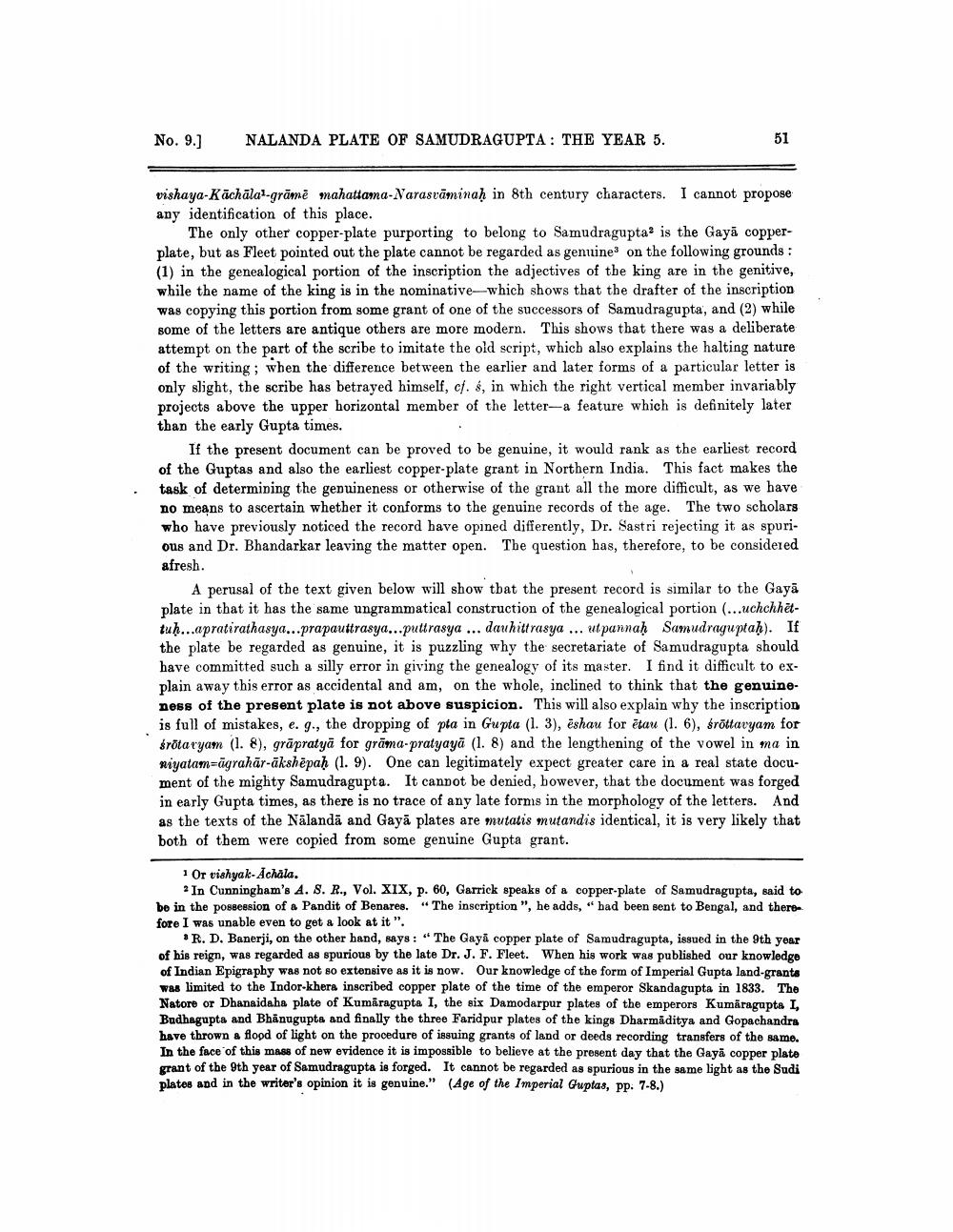________________
No. 9.]
NALANDA PLATE OF SAMUDRAGUPTA: THE YEAR 5.
51
vishaya-Kāchāla -grāmē mahattama-Narasvāminah in 8th century characters. I cannot propose any identification of this place.
The only other copper-plate purporting to belong to Samudragupta is the Gayā copperplate, but as Fleet pointed out the plate cannot be regarded as genuine on the following grounds : (1) in the genealogical portion of the inscription the adjectives of the king are in the genitive, while the name of the king is in the nominative-which shows that the drafter of the inscription was copying this portion from some grant of one of the successors of Samudragupta, and (2) while some of the letters are antique others are more modern. This shows that there was a deliberate attempt on the part of the scribe to imitate the old script, which also explains the halting nature of the writing; when the difference between the earlier and later forms of a particular letter is only slight, the scribe has betrayed himself, cf. s, in which the right vertical member invariably projects above the upper horizontal member of the letter--a feature which is definitely later than the early Gupta times.
If the present document can be proved to be genuine, it would rank as the earliest record of the Guptas and also the earliest copper-plate grant in Northern India. This fact makes the task of determining the genuineness or otherwise of the grant all the more difficult, as we have no means to ascertain whether it conforms to the genuine records of the age. The two scholars who have previously noticed the record bave opined differently, Dr. Sastri rejecting it as spurious and Dr. Bhandarkar leaving the matter open. The question has, therefore, to be considered afresh.
A perusal of the text given below will show that the present record is similar to the Gaya plate in that it has the same ungrammatical construction of the genealogical portion (...uchchhattuh...apratirathasya...prapauttrasya...puttrasya ... dauhittrasya ... utpannah Samudraguptah). If the plate be regarded as genuine, it is puzzling why the secretariate of Samudragupta should have committed such a silly error in giving the genealogy of its master. I find it difficult to explain away this error as accidental and am, on the whole, inclined to think that the genuineness of the present plate is not above suspicion. This will also explain why the inscription is full of mistakes, e. 9., the dropping of pta in Gupta (1. 3), ēshau for ētau (1. 6), śrottavyam for śrotaryam (1.8), grāpratyā for grāma-pratyayā (1. 8) and the lengthening of the vowel in ma in niyatam=ūgrahār-ākshēpah (1. 9). One can legitimately expect greater care in a real state document of the mighty Samudragupta. It cannot be denied, bowever, that the document was forged in early Gupta times, as there is no trace of any late forms in the morphology of the letters. And as the texts of the Nālandā and Gayā plates are mutatis mutandis identical, it is very likely that both of them were copied from some genuine Gupta grant.
1 Or vishyak-Achala.
2 In Cunningham's A. S. R., Vol. XIX, p. 60, Garrick speaks of a copper-plate of Samudragupta, said to bo in the possession of a Pandit of Benares. “The inscription ", he adds, "had been sent to Bengal, and there fore I was unable even to get a look at it".
*R. D. Banerji, on the other hand, says: "The Gayā copper plate of Samudragupta, issued in the 9th year of his reign, was regarded as spurious by the late Dr. J. F. Fleet. When his work was published our knowledge of Indian Epigraphy was not so extensive as it is now. Our knowledge of the form of Imperial Gupta land-grants was limited to the Indor-khera inscribed copper plate of the time of the emperor Skandagupta in 1833. The Natore or Dhanaidaha plate of Kumiragupta I, the six Damodarpur plates of the emperors Kumäragupta I, Budhegupta and Bhanugupta and finally the three Faridpur plates of the kings Dharmaditya and Gopachandra have thrown a flopd of light on the procedure of issuing grants of land or deeds recording transfers of the same. In the face of this mass of new evidence it is impossible to believe at the present day that the Gayā copper plate grant of the 9th year of Samudragupta is forged. It cannot be regarded as spurious in the same light as the Sudi plates and in the writer's opinion it is genuine." (Age of the Imperial Guptas, pp. 7-8.)




